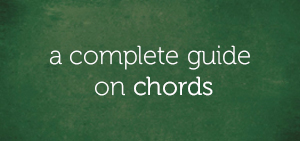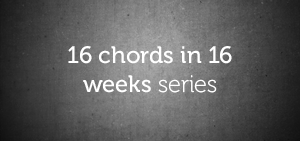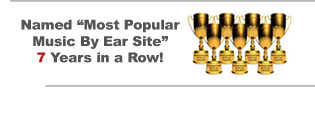If you’re interested in learning how to play in all the major keys on the keyboard, this lesson is for you.
There are twelve major keys on the piano and after getting started with the piano, a lot of people get stuck in a particular key and it becomes their comfort zone.
I agree that learning how to play in all twelve major keys is overwhelming and that’s why so many people shy away from it. However, instead of getting stuck in one key, you can learn at least 25% of all the keys on the piano and I’ll be explaining why you should in this blog.
But before we do so, let’s discuss on the concept of the major key.
“Let’s Refresh Our Minds On The 12 Major Keys…”
When musicians say “key”, what do they really mean?
The term key is used to described an environment in tonal music that is created by eight different tones with the goal of establishing particular note as a key.
For example, the C note on the keyboard:
…can be established as a key on the keyboard using the following eight components — C, D, E, F, G, A, B, and C:
It is on this environment (known as the key) that songs are played on. So, when you hear musicians say they’re in the key of C major, it simply means that the environment where C:
…is established as a key center or key:
A Short Note On The Major Key
There are two key types, the major key and the minor key.
The term major is used to describe the key type that sounds happy, cheerful, etc., while the term minor is used to describe the key type that sounds sad, sorrowful, etc.
Playing all the white notes from C to C:
…produces the C major scale:
…which is a basically an outline of all the notes in the key of C major:
Due to the relationship between the major scale and the major key, the major scale can be used to represent the major key.
“Here Are Other Major Keys On The Keyboard…”
Db major:
D major:
Eb major:
E major:
F major:
F# major:
G major:
Ab major:
A major:
Bb major:
B major:
Why You Should Play On 25% Of All The Major Keys
There are twelve major keys on the keyboard and in tonal music. Although there is no rule that says:
Thou shalt play in 25% of all the major keys.
…I’ll be giving you the theoretical basis to why you should (be able to) play on 25% of all the major keys in tonal music. But before we go any further, let’s do the math:
25% of 12 = ?????
The answer to the math above is 3. So, I’ll basically be explaining why you should be able to play on (at least) 3 out of the 12 major keys in tonal music.
The Concept Of Related Keys — Explained
Every major or minor key has two related keys.
Attention: Take note that related keys are different relative keys. We’ll deal with this elaborately in another blog.
A key and its related keys are closely related by key-signature and this means that there’s one sharp or flat difference between them.
For example, the key of C major:
…has its two related keys as follows:
F major:
G major:
A closer look at the key of C major and G major:
C major:
G major:
…shows one sharp difference; the key of G major has one sharp (F#):
…that the key of C major doesn’t have.
Also, the key of C major and F major:
C major:
F major:
…shows one flat difference; the key of F major has one flat (Bb):
…that the key of C major doesn’t have.
How To Find The Related Keys Of Any Given Major Key
The fourth and fifth tones of the major scale in any key you’re in can be used to derive the related keys. For example, in the key of E major:
…the fourth and fifth tones are:
A:
B:
Therefore, the key of E major:
…has its related keys as follows:
The key of A major:
The key of B major:
The difference between the key of E major and A major:
E major:
A major:
…is one sharp. The key of E major has 4 sharps (F#, C#, G#, and D#), while A major has 3 sharps (F#, C#, and G#).
The difference between the key of E major and B major:
E major:
B major:
…is also one sharp. The key of E major has 4 sharps (F#, C#, G#, and D#), while B major has 5 sharps (F#, C#, G#, D#, and A#).
In each of the cases, you can see the sharp difference:
E major = 4 sharps
A major = 3 sharps (one sharp difference)
B major = 5 sharps (one sharp difference)
Explained: Why You Should Play On 25% Of All The Major Keys
Related keys have scale tone chords in common. So, while learning how to play keys that are related, you’ll find chords that are common and also learn how to also borrow chords as well (a concept we’ll cover in the not-too-distant future).
For example, the C major triad:
…which is the 1 chord in the key of C major:
…is also the 5-chord in the key of F major:
…and the 4-chord in the key of G major:
The D minor triad:
…in addition to being the 2-chord in the key of C major.
“That’s Not All…”
1. The key of C major and F major have these triads in common:
C major triad:
D minor triad:
F major triad:
A minor triad:
2. The following triads are common to the key of C major and G major:
C major triad:
E minor triad:
G major triad:
A minor triad:
3. The key of C major, F major and G major have these triads in common:
C major triad:
A minor triad:
Final Words
I’m sure you’ve seen a reason to graduate from being comfortable on one key to being able to play at least three keys that are related.
If your favorite key is Db major:
…then you’ll have to focus on its related keys:
Gb major:
Ab major:
All the best and see you in the next lesson.
P.S.
Feel free to post your questions, suggestions, and comments in the comment section so we can interact.
Chuku Onyemachi
Latest posts by Chuku Onyemachi (see all)
- The Formation Of Diminished Seventh Chords Used To Be Challenging Until I Did This
- How To Form Seventh Chords In Two Shakes Of A Dog’s Tail Using Third Intervals And The Circle Of Fifths Chart
- I Played The 13sus4 Chord And This Happened…
- How To Build Seventh Chords Like An Architect Using “Foundation And Structure” Concept
- This 4-Week Plan Will Help You Master All The Major Scales







Comments on this entry are closed.